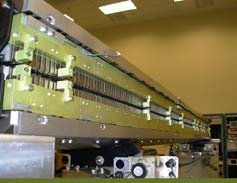
Handy Links
SLAC News Center
SLAC Today
- Subscribe
- Archives: Feb 2006-May 20, 2011
- Archives: May 23, 2011 and later
- Submit Feedback or Story Ideas
- About SLAC Today
SLAC News
Lab News
- Interactions
- Lightsources.org
- ILC NewsLine
- Int'l Science Grid This Week
- Fermilab Today
- Berkeley Lab News
- @brookhaven TODAY
- DOE Pulse
- CERN Courier
- DESY inForm
- US / LHC
SLAC Links
- Emergency
- Safety
- Policy Repository
- Site Entry Form

- Site Maps
- M & O Review
- Computing Status & Calendar
- SLAC Colloquium
- SLACspeak
- SLACspace
- SLAC Logo
- Café Menu
- Flea Market
- Web E-mail
- Marguerite Shuttle
- Discount Commuter Passes
-
Award Reporting Form
- SPIRES
- SciDoc
- Activity Groups
- Library
Stanford
Around the Bay
Filling the MMF
 One morning in mid-July, a truck rolled into SLAC with a special first delivery. A forklift eased a crate off the flatbed and delivered it to the Magnetic Measurement Facility (MMF). There, MMF technicians Scott Jansson and Ralph Colon opened
the box, and a crane lifted SLAC's first LCLS undulator to its test stand.
One morning in mid-July, a truck rolled into SLAC with a special first delivery. A forklift eased a crate off the flatbed and delivered it to the Magnetic Measurement Facility (MMF). There, MMF technicians Scott Jansson and Ralph Colon opened
the box, and a crane lifted SLAC's first LCLS undulator to its test stand.
"That's one down, and thirty nine to go," said Zack Wolf, an engineering physicist at the MMF.
The undulators are part of the LCLS project. Each has a series of magnets positioned and tuned to send an electron beam into an S-shaped path, causing the electrons to emit photons. Wolf and MMF collaborators are currently in the process of tuning the magnetic strength of each of the undulator's 226 poles—as well as of other magnets placed between them along the beam—so the electron beam always follows a precise path.
This arrival marks the first of many. The LCLS requires 40 undulators: 33 for the beam, a reference undulator, and six spares. Soon, five one-ton undulators will rotate to a new test station each week.
Before tuning can begin, the undulators must first acclimate to the MMF testing room. Because small changes in temperature affect the magnet's strength, the room is kept to within one-tenth of one degree of 20.0°C. The undulator's capacity to absorb and store heat means it took a full week for it to cool to a consistent 20.0°C.
Magnetic tuning takes two weeks. On the rough-tuning stand, engineering physicist Achim Weidemann, with software support by Seva Kaplounenko, will tune the undulator's magnetic field to force the electron pulse onto a strict path and to synchronize it with the x-ray radiation. If any magnet along the line is too strong or weak, it will push or pull the electron beam off-course.
"It's been done before with longer wavelengths," said Wolf. "Right now we're tuning for a wavelength more than a factor of ten smaller, which makes it harder to do."
After initial magnetic tuning, the undulators will be ready for the fine-tuning stand. At this stage, engineering physicist Yurii Levashov must ensure the readings come only from the undulator by magnetically shielding the instrument from external effects like the Earth's magnetic field, electric motors—even current flowing through nearby wires—by wrapping it in a magnetic shield which looks like sheet metal.
Ultimately, the undulator is tuned so that the beam stays on course to two microns—one quarter the width of a human hair—and it will stay synchronized to the radiation to within 10 degrees.
Tuners will spend one last week determining where the tuned beam lies within the instrument. This will allow them to align all 33 undulators perfectly along the electron beamline.
With the successful testing of the first undulator, the other 39 instruments should start arriving in September. "We have a lot of work to do," said Wolf, "but it's an exciting process."
—Krista Zala
SLAC Today, August 15, 2006
The first of the MMF's 40 undulators. (Click on image for larger version.)